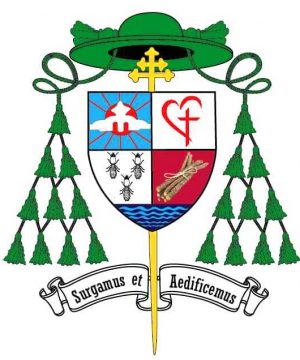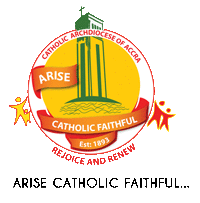UNDERSTANDING COAT OF ARMS OF ARCHBISHOP KWOFIE
The Coat of Arms of Archbishop Kwofie is below. The following is the explanation offered by Archbishop Kwofie himself.
EXPLANATION OF COAT OF ARMS
1. On the upper left part is the dove symbolizing the Holy Spirit. The Holy Spirit is the Patron of the Archdiocese of Accra and also of the Spiritan family of which the Archbishop is a member. The dove is seen here descending on the world. The red rays symbolize the creative force of the Holy Spirit that fills our world, embracing all the faithful and binding us together to form one spiritual family. The power of the Holy Spirit is at work in the world re-creating us into the image of God.

2. We see on the lower left part termites which are the symbol of Accra (called Ga in the local language). The Ga represent themselves by termites and the termite hills (Gbotsui ma dani Ghana ba!) which abound in Accra, there used to be some around Achimota. Three termites stand for community and communion, and termites are well known for their orderliness and respect for hierarchy as well as for individual responsibility for the social well-being of all.
3. The upper right part are the heart and the cross symbolizing the Sacred Heart of Jesus. It is a sign of love and self-giving that surpasses all understanding and calls us to learn from Him. The heart stands for peace, love and compassion. Through the cross, Jesus demonstrated boundless love that brought salvation to humanity. Committed to the Sacred Heart of Jesus, the symbol in the Coat of Arms reminds us to love and compassion in return. Love is a mission that brings peace and builds communion.
4. On the lower right is a bunch of sticks bound together with a rope symbolizing strength in unity. This symbol is special to the Ahanta people of the Western Region to which belongs the Archbishop. The Ahanta have an adage that says, “owudo ko bayikyi”, literally meaning “one does not bind a piece of wood with a rope” or “it takes two or more sticks to be bound together with a rope”. The symbol recognizes individual uniqueness whist reminding us of the strength we derive from community, unity, togetherness, connectedness, oneness, communion, bonding, etc. The rope binding the sticks together is important because its strength determines the extent to which it can hold the sticks together.
5. Underneath the symbols of the termites of the Ga and the sticks bound together of the Ahanta people is the sea. The Archdiocese of Accra lies along the sea so also is the Diocese of Sekondi-Takoradi where the Archbishop comes from. For the people of Accra, the sea represents divine providence known as Nai. It is from the sea that the Ga claim they came and whenever in danger they take refuge. Besides, Ga earn their living by the sea and in the sea. The sea also represents the fishing activities for sustenance of the people of Ahanta in the Western Region. As Christians, we are bound together by the waters of baptism. This is the communion that each one is called to protect and at the same time to promote.
6. The episcopal motto of the Archbishop, “Surgamus et Aedificemus”, the Latin for “Let Us Rise and Build Together” is inspired by the story of Nehemiah. The challenges facing our Church today is everybody’s business. Building our Church is the responsibility of all of us – priests, religious and lay people. There is no room for on-lookers. All Christ’s faithful in the Archdiocese of Accra are, therefore, exhorted to join hands to continue the work of evangelization started by our predecessors 125 years ago.

